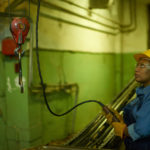Crane Inspections: Why, How and How Often

If you’ve recently had a crane installed at your workplace, you may not yet be an expert on the reasons why it needs to go through inspection, how often it needs to happen, and who is qualified to perform the inspection.
Below, find everything you need to know about your crane’s inspections, including frequency, required documentation, certified inspectors and more.
Why does my crane need inspection?
OSHA requires that all active cranes be annually inspected. Daily or weekly usage wears important crane components. This wear can lead to a breakdown — or worse, a dangerous failure that puts you, your team or your company at risk.
Routine inspections can help identify potential problems and address them before a costly or irreversible incident occurs.
Who is qualified to inspect my crane?
According to the Crane Manufacturers Association of America (CMAA), a crane inspector should have at least 2,000 field hours of experience directly related to the maintenance, servicing, repairing, modifying and functional testing of cranes and the hoist equipment.
CMAA states that under no circumstances should an individual perform inspections if they have not received appropriate training and do not have knowledge of the applicable codes and regulations of the equipment.
CMAA also states the inspector should have formal training in the areas of:
Safety and design codes that are related to overhead cranes
Federal, State and local codes and standards
Safe operating practices of cranes and hoists
Understanding of how to write a report and documentation procedures
Knowledge of crane and hoist terminology to effectively communicate
How often should I get my crane inspected?
According to the American National Standards Institute (ANSI), there are four categories for overhead crane inspections: Initial, Functional, Frequent, and Periodic.
1. Initial Inspection
The following excerpt is from OSHA 1910.179: “Prior to initial use all new and altered cranes shall be inspected to insure compliance with the provisions of this section.”
The initial inspection is a documented visual inspection that is required after installing a new crane or hoist, and for equipment that has been reinstalled after alteration, modification or repair.
For overhead cranes, ANSI B30.11 also requires a Rated Load Test: “Prior to initial use, all new, extensively repaired, and altered equipment shall be tested and inspected by, or under the direction of, an appointed or authorized person, and a written report should be furnished by such person, confirming the load rating of the system. The load rating should be no more than 80% of the maximum load sustained during the test.”
2. Functional Test Inspection
Before every shift, the functionality of your crane must be tested. According to OSHA you need to visually test the following on a daily basis:
- The functional operating mechanisms for maladjustment interfering with proper operation;
- Deterioration or leakage in lines, tanks, valves, drain pumps and other parts of air or hydraulic systems;
- Hoist chains, including end connections, for excessive wear, twist, distorted links interfering with proper function, or stretch beyond manufacturer’s recommendations. This step also requires a monthly inspection with a certification record which includes the date of inspection, the signature of the person who performed the inspection, and an identifier of the chain which was inspected;
- Hooks with deformation or cracks. Like hoist chains, this also requires monthly inspection with a certification record which includes the date of inspection, the signature of the person who performed the inspection and the serial number, or other identifier, of the hook inspected;
- All functional operating mechanisms for excessive wear of components; daily to monthly intervals and
- Rope reeving for noncompliance with manufacturer’s recommendations, on a daily or monthly interval.
3. Frequent Inspection
Frequent Inspections should include all aspects of the Functional Test Inspection, in addition to checking the operating mechanisms. The inspector should pay particular attention to the hoist brake, wire rope, load chain, and by listening for any abnormal sounds. The hook and latch requires an inspection as well.
The frequency which these inspections should take place is based upon the usage of your crane: A crane which operates under “normal service” should be inspected monthly; a crane in “heavy service” should be inspected weekly to monthly; and a crane in “severe service” should be inspected daily to weekly.
The Frequent Inspection does not require a record like the functional test inspection, but documentation will show that the overhead crane has been inspected, so all operators will know it is safe to use before they start their shift. The documentation will also show that you are proactive about your facility’s safety, which can work in your favor if an accident occurs in the future.
4. Periodic Inspection
Like the Frequent Inspection, the frequency of the Periodic Inspection is based on the usage of the crane.
For this inspection, cranes which are used for “normal service” and “heavy service” should be inspected yearly. Cranes in “severe service” should be inspected quarterly. (In California, quarterly preventive maintenance is required regardless of the service class.)
For cranes in normal and heavy service, a Periodic Inspection should include checking for:
- Deformed, cracked or corroded members
- Loose bolts or rivets
- Cracked or worn sheaves and drums
- Worn, cracked or distorted parts such as pins, bearings, shafts, gears, rollers, locking and clamping devices
- Excessive wear on brake system parts, linings, pawls and ratchets
- Load, wind and other indicators over their full range, for any significant inaccuracies
- Gasoline, diesel, electric or other power-plants for improper performance or noncompliance with applicable safety requirements
- Excessive wear of chain drive sprockets and excessive chain stretch
- Electrical apparatus and signs of pitting or any deterioration of controller contractors, limit switches and pushbutton stations
According to OSHA, if you have a crane that has not been used in more than a month, but has been used within the last sixth months, you will be required to perform a Periodic and Functional Test Inspection prior to its next use.
The same regulation applies if the crane has not been used in over six months to over a year.
The manufacturer of your overhead crane may require additional inspections at various intervals. Your crane’s owner’s manual will list these requirements, so make sure you keep a copy handy for reference.
It may seem costly and time-consuming to follow all the required inspections for your overhead crane. However, these maintenance and safety checks are much cheaper than the legal fees and insurance premiums you’ll have to pay if someone on your team is injured because the inspections never happened, or if the inspections were performed by someone who was not qualified.
Learn more about our certified, professional inspections >










